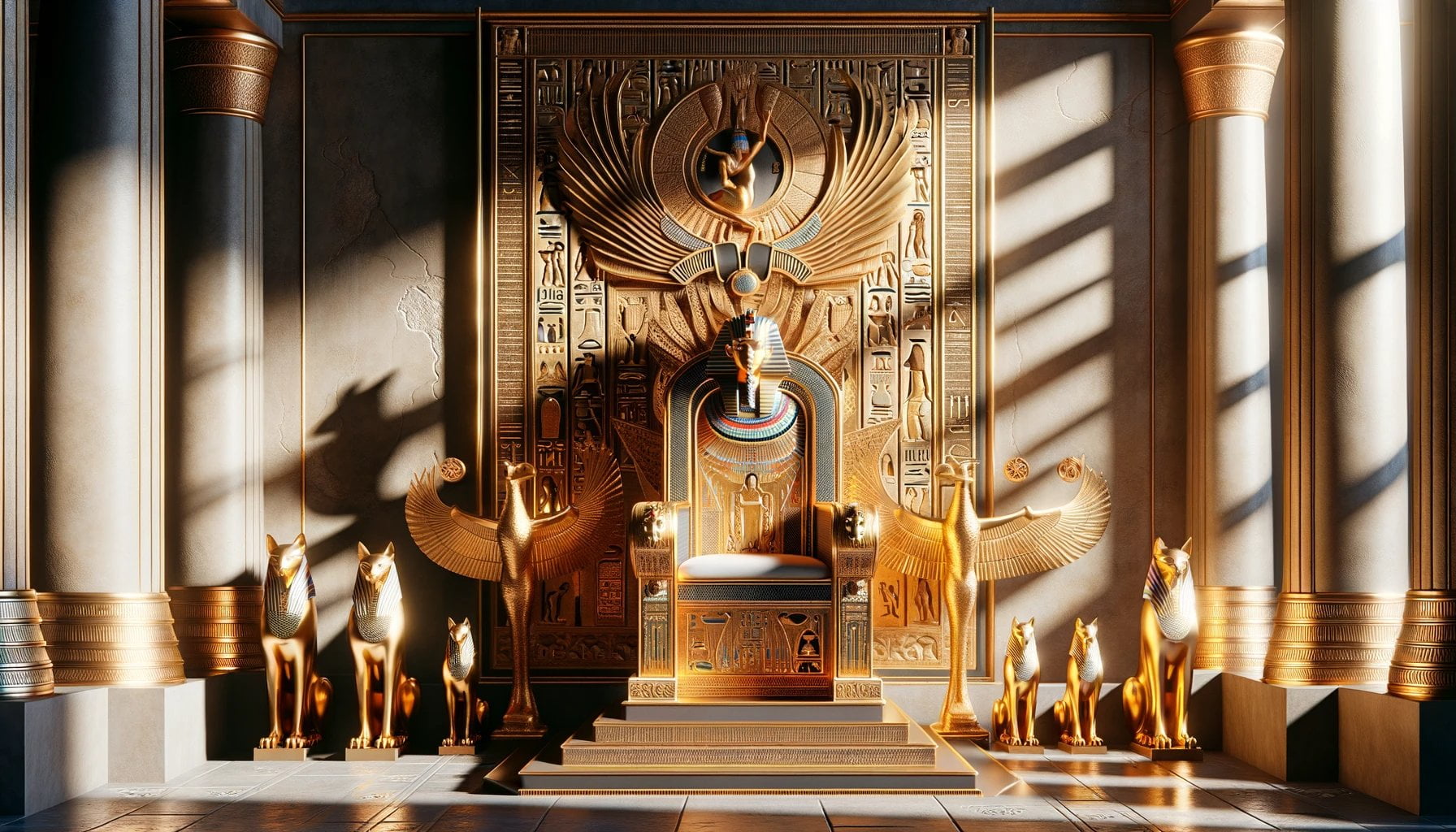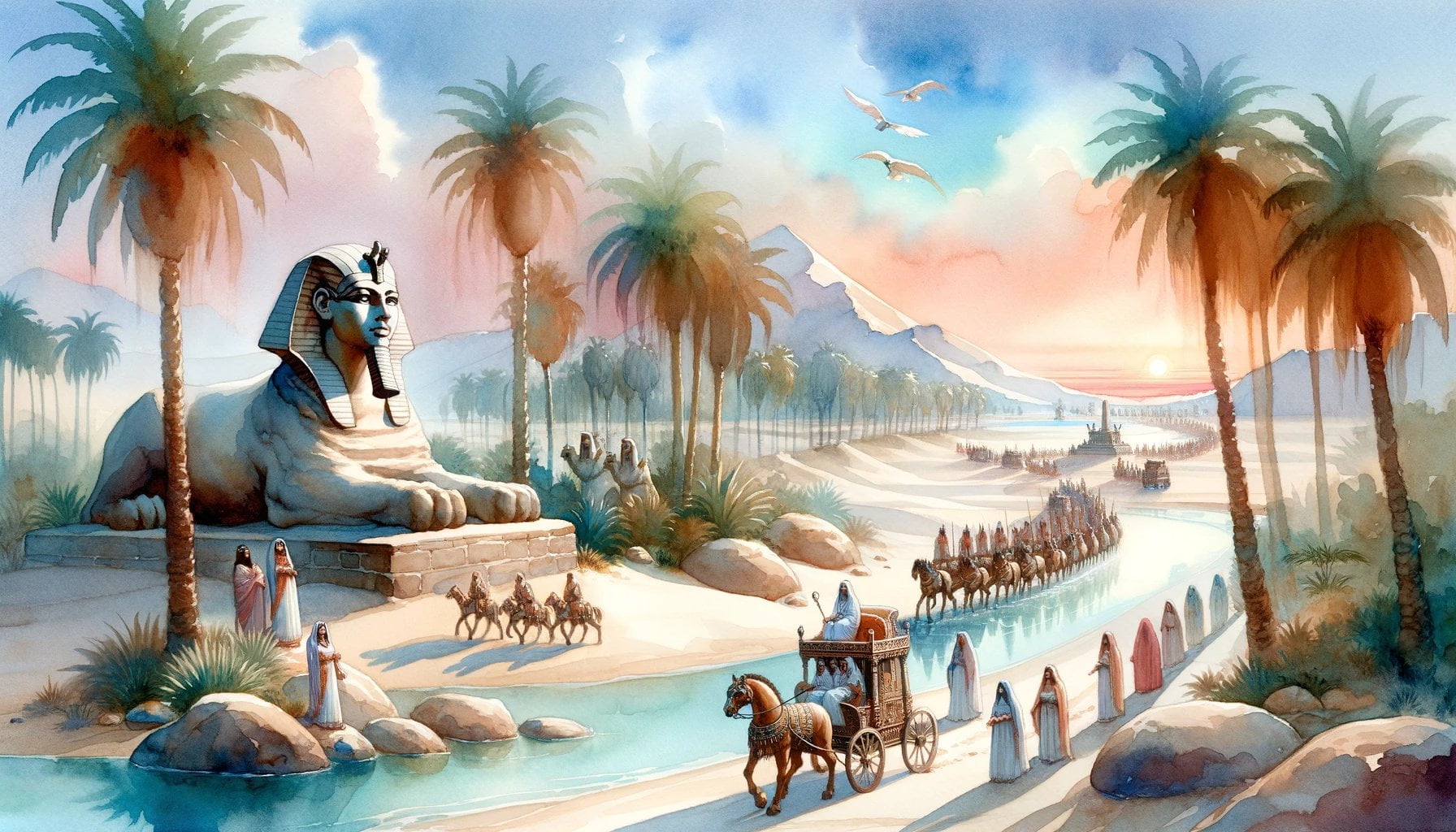Welcome to a captivating journey through the illustrious reigns of the ancient queens of Egypt – an exploration into the lives of extraordinary female leaders who left an indelible mark on the civilization that flourished along the banks of the Nile. From the enigmatic Cleopatra to the formidable Hatshepsut, these influential queens have long been shrouded in mystery, their stories waiting to be unearthed. As we delve into the intricate tapestry of their rule, we will uncover the untold tales of power, intrigue, and legacy, shedding light on the remarkable women who shaped Ancient Egypt.

Key Takeaways:
- Egyptian queens played crucial roles in the king’s right to rule and held significant positions in family, official, and religious affairs.
- Cleopatra, the famous Egyptian queen, was the last ruler of the Macedonian dynasty in Egypt and is widely recognized for her reign.
- Despite being a famous Egyptian queen, Cleopatra was actually of Greek ethnicity.
- Hatshepsut, another notable Egyptian queen, ruled for 21 years and brought stability and prosperity to Egypt.
- Hatshepsut’s mortuary complex at Deir el-Bahri served as an influential inspiration for future pharaohs, leaving a lasting legacy.
Ancient Queens of Egypt
Unraveling the Enigmatic Stories of Remarkable Female Leaders
Egypt, the land of pyramids and pharaohs, holds a mesmerizing history that spans thousands of years. Within this rich tapestry of civilization, the stories of powerful queens emerge as beacons of influence, defying the patriarchal norms of their time. Let us embark on a journey to unveil the lives and legacies of the ancient queens of Egypt, shedding light on their remarkable feats and invaluable contributions to the nation’s enduring heritage.
The Essential Role of Egyptian Queens
In ancient Egypt, the queens played vital roles in the kingdom’s governance, family life, and religious affairs. They were not mere consorts to the pharaohs but held considerable power and authority. Influential behind the scenes, they cemented the king’s right to rule and ensured the succession of their descendants. The queens were revered as divine mothers, nurturing the royal lineage and guiding the nation with wisdom and grace.
The Illustrious Cleopatra: Last of the Macedonian Dynasty
One name stands out when we think of ancient queens – Cleopatra. Renowned for her beauty, intellect, and captivating allure, she was the last ruler of the Macedonian dynasty that reigned over Egypt. However, it is a little-known fact that Cleopatra was Greek by ethnicity, not Egyptian. But her impact on Egyptian history cannot be overstated.
Cleopatra’s reign was marked by political intrigue and alliances, as she sought to protect her kingdom from outside threats. Her relationships with Julius Caesar and Mark Antony are the stuff of legends, intertwining her fate with that of Rome. Despite her ultimate defeat, Cleopatra’s legacy remains indelible, showcasing the strength and resilience of an Egyptian queen who left an indelible mark on history.
Hatshepsut: A Journey of Peace and Prosperity
While Cleopatra may be the most famous queen, Hatshepsut holds her own as one of the most influential. Breaking traditions, she ascended to the throne and reigned as pharaoh for an astounding 21 years during the New Kingdom period. Hatshepsut’s reign was marked by peaceful expansion, remarkable architectural achievements, and cultural advancements.
One of her most awe-inspiring legacies is her mortuary complex at Deir el-Bahri, nestled against the cliffs of Thebes. This complex not only served as her final resting place but also inspired generations of pharaohs with its grandeur and architectural prowess. Hatshepsut’s reign proves that a powerful queen could usher in an era of peace and prosperity, leaving an indelible impact on Ancient Egypt.
Exploring the Lives of Other Queens
While Cleopatra and Hatshepsut stand out, they are just a glimpse into the rich tapestry of Egyptian queenship. Other queens such as Nefertiti, known for her beauty and role in religious reform, or Nefertari, who mesmerized Egypt with her grace and elegance, also held immense influence. Each queen contributed to the complex tapestry of Egyptian history, their stories weaving together to create a vivid portrait of female leadership in a bygone era.
By delving into the lives of these remarkable women, we gain a deeper understanding of the roles they played in shaping the destiny of Egypt. From political maneuvers to cultural advancements, their footprints linger on the sands of time, their contributions immortalized in the annals of history.
Unveiling the Legacy
The ancient queens of Egypt left behind a rich legacy that transcends time and continues to captivate the imagination of people around the world. Their stories are a testament to the power of female leadership and the profound impact it can have on a nation’s destiny.
As we immerse ourselves in the enigmatic tales of these influential queens, we unlock the secrets of the past and uncover the hidden truths that reveal their true essence. The ancient queens of Egypt stand as icons of strength, wisdom, and resilience, shattering the boundaries imposed upon them and forever changing the course of history.
Let us honor their memory and embrace the extraordinary legacies they have bequeathed. The ancient queens of Egypt deserve their place in the annals of history, as trailblazers who defied norms, shattered expectations, and reigned supreme in a world that often sought to confine them.
Table: Key Ancient Queens of Egypt
| Queen | Reign Period | Notable Achievements |
|---|---|---|
| Cleopatra | 51-30 BC | Political alliances, cultural patronage |
| Hatshepsut | 1479-1458 BC | Peaceful reign, architectural marvels |
| Nefertiti | 1370-1330 BC | Religious reform, iconic bust |
| Nefertari | 1290-1224 BC | Political diplomacy, stunning tomb |
| MerNeith | 3000 BC | Possible first female ruler, military prowess |
Ancient Egypt is steeped in history and mystery, with its ancient temples holding the secrets of a fascinating civilization. If you’re curious to explore these wonders, be sure to check out the Ancient Temples of Egypt. Discover the timeless beauty and architectural brilliance of these ancient structures by clicking here.
Notable Queens of the Old Kingdom
The history of Ancient Egypt is filled with remarkable female leaders who left an indelible mark on society. From the Old Kingdom, we uncover the stories and legacies of queens who influenced the course of Egyptian civilization. In this article, we dive into the lives and achievements of these Notable Queens of the Old Kingdom, shedding light on their contributions and the significance they held in ancient Egypt.
The Power of Queens in Ancient Egypt
In ancient Egypt, queens held vital roles in governance, family life, and religious affairs. They were not just consorts to pharaohs; they were powerful figures in their own right. Symbolizing the powers of creation and rebirth, queens played a crucial role in maintaining the order and prosperity of the kingdom.
Hatshepsut: The Powerful Pharaoh Queen
One of the most influential queens of the Old Kingdom was Hatshepsut. Breaking convention, she ruled as a pharaoh during the 18th dynasty. Her reign lasted 21 years and was known for its peaceful expansion, architectural achievements, and cultural advancements. Hatshepsut’s legacy endures through her impressive monuments and trade expeditions that enhanced Egypt’s prosperity.
Nefertiti: Beauty and Religious Reform
Another notable queen of the Old Kingdom was Nefertiti. Known for her beauty and religious reform, Nefertiti was the wife of Pharaoh Akhenaten during the Amarna period. She held significant influence in shaping the religious landscape of ancient Egypt, promoting the worship of the sun god Aten. The iconic bust of Nefertiti, instantly recognizable and captivating, immortalizes her place in history.
Nefertari: Diplomat and Patron of the Arts
Nefertari, the wife of Pharaoh Ramesses II, played a pivotal role as a diplomat and patron of the arts. Her tomb, adorned with breathtaking artwork, reflects her support for cultural expression. Nefertari’s influence extended beyond the palace walls, as she forged political alliances and advocated for the prosperity and stability of Egypt.
Tawosret: The Last Pharaoh of the 19th Dynasty
The final queen we explore from the Old Kingdom is Tawosret, the last pharaoh of the 19th dynasty. Tawosret’s reign was marked by her determination to defend Egypt against invading forces. Her resilience and bravery in the face of adversity make her a notable figure in ancient Egyptian history.
Key Takeaways:
- Hatshepsut ruled as a pharaoh, expanded trade, and left behind impressive monuments.
- Nefertiti influenced religious reform and is renowned for her beauty.
- Nefertari acted as a diplomat, patron of the arts, and left a stunning tomb.
- Tawosret fiercely defended Egypt as the last pharaoh of the 19th dynasty.
The queens of the Old Kingdom embody the strength, intelligence, and leadership that shaped ancient Egypt. Their stories captivate scholars and continue to intrigue us, unveiling the untold tales of influential female leaders who left an enduring legacy in the sands of time.
The Influential Queens of the Middle and New Kingdoms
Key Takeaways:
- Hatshepsut was one of the most powerful and influential queens in ancient Egypt, reigning for 21 years and known for her peaceful expansion, architectural achievements, and cultural advancements.
- Nefertiti, another iconic queen, left a lasting impact on Egyptian history with her beauty and religious reforms.
- Tomyris, the queen of the Massagetae, was a formidable ruler in her own right.
- Arsinoe II, a queen of ancient Thrace and Egypt, played a significant role in the political landscape.
- Cleopatra VII, the last queen of ancient Egypt, is widely regarded as one of history’s most famous queens, known for her alliances with Julius Caesar and Mark Antony.
In the enigmatic realm of ancient Egypt, the stories of extraordinary queens hold an undeniable allure. Rooted in history and shrouded in mystique, these influential female leaders from the Middle and New Kingdoms shaped the Egyptian civilization and left an indelible mark on our collective consciousness. Let us embark on a journey to unveil the remarkable lives of these queens, exploring their achievements, contributions, and the fascinating historical events in which they played a pivotal role.
Hatshepsut: The Peaceful Expansionist
One queen who stands out prominently is Hatshepsut. With an astonishing reign spanning 21 years, she earned her place as one of the most powerful rulers of Egypt. Hatshepsut’s peaceful expansion, remarkable architectural achievements, and cultural advancements make her an influential figure in Egyptian history. Breaking gender barriers, she assumed the title of pharaoh and established herself as a capable leader, shaping the course of the Middle Kingdom.
Nefertiti: Beauty and Religious Reforms
The name Nefertiti conjures images of beauty and splendor. This iconic queen left an indelible mark on Egypt’s religious landscape. As the wife of Pharaoh Akhenaten, Nefertiti played a crucial role in his religious reforms, which worshiped the sun disc, Aten, as the supreme deity. Her captivating beauty, immortalized in her iconic bust, continues to fascinate and inspire to this day.
Tomyris: Power Across Borders
While not an Egyptian queen, Tomyris, the queen of the Massagetae, deserves recognition for her significant influence. As a powerful ruler in her own right, Tomyris commanded her kingdom with strength and authority. Her encounter with the Persian ruler Cyrus the Great became the stuff of legends, showcasing her prowess and determination.
Arsinoe II: A Queen of Multiple Realms
Moving beyond the borders of Egypt, we come across Arsinoe II, a queen who held influence in both ancient Thrace and Egypt. Through strategic alliances and political maneuvering, Arsinoe II played a vital role in the political landscape of her time. Her reign left an enduring legacy and demonstrated the power wielded by ancient queens.
Cleopatra VII: The Last Pharaoh
No list of influential queens would be complete without mentioning Cleopatra VII. Renowned as one of history’s most famous queens, Cleopatra’s alliances with Julius Caesar and Mark Antony continue to captivate scholars and enthusiasts alike. With her intelligence, charisma, and political acumen, she played a pivotal role in the events that would ultimately lead to the demise of ancient Egypt’s independence.
As we delve into the stories of these extraordinary queens, we uncover a tapestry woven with political intrigue, cultural achievements, and the indomitable spirit of female leadership. The Middle and New Kingdoms of Egypt were witness to the rise and reign of these influential royal women, shaping the course of history and leaving behind a rich legacy that continues to inspire us today.
So let us journey through time, peeling back the layers of history, and embracing the indomitable spirit of the influential queens of the Middle and New Kingdoms.
The Legacy and Impact of the Queens of Ancient Egypt
Empowered, influential, and enigmatic, the queens of Ancient Egypt left an indelible mark on history. Through their reigns, they not only shaped the Egyptian civilization but also defied societal norms and expectations. Join me on a captivating journey as we delve into the lives of these remarkable female leaders and uncover their lasting legacy and profound impact.
The Power of Ancient Queens
In the male-dominated world of Ancient Egypt, queens held vital roles in governance, family life, and religious affairs. Their influence was significant, though often hidden from historical records. While Cleopatra, the renowned queen of the Macedonian dynasty, is well-known for her alliances with Julius Caesar and Mark Antony, the most powerful queen was, in fact, Hatshepsut. Reigning for an astonishing 21 years, Hatshepsut’s peaceful expansion, architectural achievements, and cultural advancements made her a true force to be reckoned with.
Unveiling Hidden Legacies
While some queens, like Nefertiti and Nefertari, are widely known for their beauty or political diplomacy, many ancient Egyptian queens have been lost to history or remain subjects of dispute among Egyptologists. As Egypt gained stability through periods of rule by women, these queens took on the responsibility of leading the kingdom, sometimes on behalf of their young sons, rather than allowing male relatives to serve as regents.
Rediscovering Ancient Queens
- MerNeith, speculated to be the first female ruler of Egypt with military prowess.
- Tawosret, the last pharaoh of the 19th dynasty, who defended Egypt against invading forces.
- Tomyris, queen of the Massagetae, who proved to be a formidable ruler.
- Arsinoe II, who played a significant role in politics in both ancient Thrace and Egypt.
Ancient Queens: Pillars of Stability and Leadership
In Ancient Egypt, the king’s role was considered the apex and organizing principle of society. However, the inclusion of female leadership, as seen in the queens, brought stability and a unique perspective to the realm. These queens contributed not only to the governance and welfare of their kingdom but also to the preservation of Egyptian traditions and culture.
Key Takeaways:
- Ancient queens of Egypt held vital roles in governance, family life, and religious affairs.
- Hatshepsut was a powerful pharaoh queen known for peaceful expansion and cultural advancements.
- Nefertiti left a lasting impact with her beauty and religious reforms.
- Nefertari, wife of Pharaoh Ramesses II, was a diplomat and patron of the arts with a stunning tomb.
- MerNeith is speculated to be the first female ruler of Egypt with military prowess.
- Tomyris, queen of the Massagetae, was a formidable ruler.
- Arsinoe II played a significant role in politics in both ancient Thrace and Egypt.
- Cleopatra VII, the last queen of ancient Egypt, is famous for her alliances with Julius Caesar and Mark Antony.
In conclusion, the legacy and impact of the queens of Ancient Egypt transcend time. Their presence brought stability and innovation, leaving an enduring imprint on history and captivating the imagination of people around the world. Join us as we uncover the untold stories and unveil the remarkable achievements of these influential female leaders.
References:
Ancient Egypt. (n.d.). https://education.nationalgeographic.org/resource/resource-library-ancient-egypt/
Bowman, A. K., Wente, E. F., Dorman, P. F., Samuel, A. E., & Baines, J. R. (2023, September 30). Ancient Egypt | History, Government, Culture, Map, & Facts. Encyclopedia Britannica. https://www.britannica.com/place/ancient-Egypt
Ancient Egypt. (2023, September 27). Wikipedia. https://en.wikipedia.org/wiki/Ancient_Egypt

FAQ
Q1: Who were the influential queens of Ancient Egypt?
A1: Some of the influential queens of Ancient Egypt include Hatshepsut, Nefertiti, Cleopatra VII, Nefertari, and Tawosret.
Q2: What role did queens play in Ancient Egypt?
A2: Queens in Ancient Egypt had essential roles in the king’s right to rule and played important roles in family, official, and religious life. They often symbolized the powers of creation and rebirth.
Q3: Was Cleopatra Egyptian or Greek?
A3: Cleopatra, the last queen of Ancient Egypt, was Greek by ethnicity, not Egyptian.
Q4: How long did Hatshepsut reign as queen?
A4: Hatshepsut, one of the notable queens of Ancient Egypt, reigned for 21 years and brought peace and prosperity to Egypt.
Q5: What was the significance of Hatshepsut’s mortuary complex?
A5: Hatshepsut’s mortuary complex at Deir el-Bahri inspired generations of pharaohs and left a lasting legacy in Ancient Egyptian history.
- Unraveling Einstein’s Legacy: Who Inherited His Genius? - July 14, 2025
- Unlock Einstein’s Family Tree: Bernhard Caesar & Untold Stories - July 14, 2025
- Unveiling Bernhard Caesar Einstein: His Life & Albert Einstein’s Legacy - July 14, 2025
















